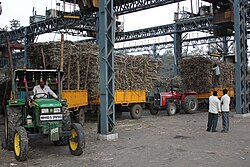Economy of India
The economy of India is the fifth largest in the world with a GDP (a year's goods and services) of US$3.94 trillion. If considered PPP (purchasing power parity (how much that money can buy in India compared to other countries), the economy is the third largest (worth US$12.51 trillion). Measured by population it was 125th in the world in 2022.[1]
India's economy includes agriculture, handicrafts, industries, and a lot of services. The service sector is the main source of economic growth in India today, though two-thirds of Indian people earn their living directly or indirectly through agriculture. In recent times, due to its many well-educated people who can speak English, India became a pioneer in information technology.
For most of India's independent history, it had strict government controls in many areas such as telecommunications (communication over long distances), banking and foreign direct investment. In 1967 70% of the people earned less than 150 rupees a month.[2] Since the early 1990s, India has slowly opened up its markets by reducing government control on foreign trade and investment. This was started by Manmohan Singh under the leadership of P. V. Narasimha Rao. From then, the Indian Economy grew at a rapid pace.
The Indian rupee (₹) is the money in India. In 1947 an American dollar was worth about 3 rupees. In 2022 it was worth about 75 rupees.[3]
The social and economic problems India faces are the increasing population, poverty, lack of infrastructure (buildings, roads, etc.) and growing unemployment.
Economy Of India Media
Navi Mumbai built during pre-liberalization
India exports more than 100,000 tonnes (98,000 long tons; 110,000 short tons) of processed cashew kernels every year. There are more than 600 cashew processing units in Kollam alone.
Sugarcane weighing at a Pravara Sahakari Sakhar Karkhana Ltd in Maharashtra
References
- ↑ "GDP per capita, current prices". International Monetary Fund. Retrieved 2023-03-04.
- ↑ Stark Murray, David (1967). India- Which Century. London: Victor Gollancz. pp. 53.
- ↑ "USDINR=X Interactive Stock Chart | USD/INR Stock - Yahoo Finance". finance.yahoo.com. Retrieved 2023-03-04.









